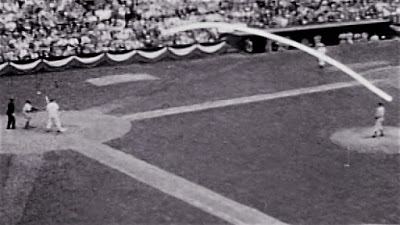The concept of confusing opposing hitters is a key to any pitcher’s success across any baseball league, from an early age at the little league level to the professional level, including the MLB. As a result, pitchers constantly look for ways to edge out the competition by increasing pitch velocity, putting more spin on the ball, and getting more movement in their pitch.
Enter the eephus pitch, an unpopular, difficult-to-throw pitch known for its low speed and ability to catch hitters off-guard.
What is an eephus pitch, and where does it get its name from? Read on to learn more about the eephus pitch, how to throw, how to grip, and what players have used this pitch in their pitching arsenal.
What Is an Eephus Pitch?
This pitch isn’t as easy to define as better-known pitches like the two-seam fastball or the knuckleball, known by their baseball grip.
Instead, the eephus pitch is an off-speed junk pitch adapted in the 1940s to create confusion among opposing hitters. This pitch is slow (40-50 miles per hour) and thrown in a high ward trajectory with a break over home plate resembling a slowpitch softball’s pitch.

The eephus pitch will often catch hitters off-guard, forcing them into swinging too hard too early. However, for hitters who can keep it together, this pitch is one of the easiest ones to hit since it doesn’t carry excessive speed or movement.
Why Is It Called an Eephus Pitch?
Historians believe the association is to the Hebrew word “efes,” meaning “nothing.” The eephus pitch has little to no speed or movement.
Like many other pitches, it’s hard to put an exact time frame on when the eephus pitch first appeared in baseball. Still, many believe it appeared as a regular pitch during the 1940s, believed to have been invented by former Pittsburgh Pirates pitcher Rip Sewell.
He used the pitch in the 1940s, including in the 1946 All-Star game against Ted Williams.
How to Throw an Eephus Pitch & the Eephus Pitch Grip
The eephus pitch can be thrown in various ways with different arm angles. In theory, it is gripped like a fastball, thrown over the top at the 12 o’clock position with little to no speed on the ball, and released when coming up to allow for a high arching trajectory with the intention to make a downward angle to Homeplate.
Since the pitch is designed to be thrown slow, the arm motion will be slower to reduce the speed of the ball.
However, since most pitches at the professional level are much faster, typically in the 80 or 90 miles per hour range, it can create confusion and sometimes an erratic swing leading to missing the ball or hitting the ball weak for an out.
The pitch has little movement from left to right but a downward path to home plate. Since the ball is coming in high, the eephus pitch will drop quickly for the hitter, making it sometimes difficult to hit.
The eephus pitch for both lefties and righties will have a similar break downwards to Homeplate. While the eephus pitch grip may vary, it could cause an alternating spin to go down to the left or right, depending on the arm angle and slot of release.
Eephus Pitch Speeds?
The eephus pitch can vary in speed but is typically in the range of mid to upper 40s to mid-50s on the radar gun and used to force the hitter to slow his bat down or mistime the pitch.
How to Throw Without Hurting Your Arm?
Since the eephus pitch is not a traditional standard pitch many have seen thrown before, many wonder how safe it is to throw, and whether it can lead to arm injuries.
Like any other pitch, the pitcher must learn how to throw an eephus pitch correctly, learn the eephus pitch grip, and ensure they aren’t putting pressure on their wrist or elbow when releasing the ball.
Throwing the ball overhand at the 12 o’clock position with no twist ensures the pitcher will not hurt their arm.
Pros and Cons
The pros and cons vary depending on who you ask because the pitch has little speed, little break, and can potentially be timed and hit a very long way. However, the eephus pitch has worked well in the past, and continues to be thrown at various times over the course of any MLB season.
The pros of the eephus pitch are that it is typically safe to throw, can confuse opposing hitters and puts little to no pressure on the pitcher’s arm.
The cons of the eephus pitch is that it is very slow, has little to no movement and can be hit far if well timed up.
Who Throws This Pitch in MLB?
Since the eephus pitch is legal, any MLB pitcher can throw it. This pitch has been used by a number of positional players, including Yadier Molina, and starting pitchers such as Bob Tweksbury, Rip Sewell, Zach Grienke, Orlando Hernandez, and Clayton Kershaw.
Best Eephus Pitch in the History of Baseball?
Since the eephus pitch is not a traditional pitch and isn’t thrown by many, some consider the Zach Grienke’s eephus pitch as one of the best eephus pitches in MLB history.
Conclusion
As we wrap up, take the time to research the eephus pitch, learn how to throw an eephus pitch, and even YouTube famous MLB players to have used the eephus pitch within a game.